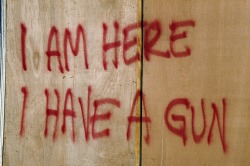
Interest in a “Katrina rifle” grew almost overnight after Hurricane Katrina turned from a woman’s elegant name, to a tragic hurricane, to an adjective for a tangible survival situation. So when the word Katrina is used to qualify a rifle, it should be clear that the intended use of the rifle will not be for anything fun.
Related: The Katrina Pistol
This particular Katrina Rifle (KR) project takes into to consideration the likely environment in which it may come into play for me; namely the western US. Defining that playground, some of of the conditions that the rifle must operate within include a wide temperature range from freezing blizzard to forest fire. Targets could be anywhere from point blank to 300 yards away. The gun must run in full daylight, in darkness, and any lighting in between.
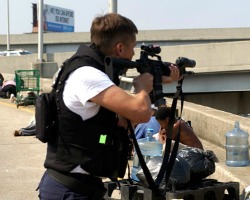
The rifle will be carried for 99.99 percent of its life so lightweight and comfort must be considered. It must be intensely reliable, of common caliber, and have replaceable parts. Finally, it must be as simple as possible but not any more so. Therefore every part and aftermarket add-on must be worth its weight in survival. So far, this might sound like every other rifle build. The list of jobs this rifle will fulfil include general security, close quarter combat, night patrols, long and short range hunting, 24/7 carry, long range shots, rapid fire, sniping, operating when dry, wet, and abused.
The Katrina Rifle Platform
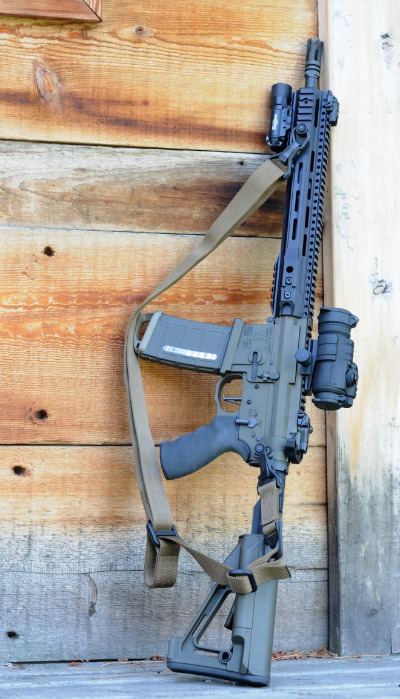
Of the three popular actions, pump, bolt and semi-auto, the latter is the one of choice. Being able to repeatedly fire with only one hand is more important than anything the other two actions have to offer. While the semi-auto may have feeding or ejection issues where the pump and bolt won’t, I am going to take the risk on the semi-auto action.
So as a semi-auto rifle, the next question is what major platform, AK or AR? If AK, then the the two choices are 5.45×39 or 7.62×39. If AR, then it is 5.56/.223 or .308. Frankly, any of the four would be great options so this could be considered a judgement call by the operator.
In this case, even though I think the AK platform is the most durable and reliable and I even have time behind the sights of a full auto AK, I am going the AR route due to the proliferation of quality and proven aftermarket add-ons that will suit my Katrina Rifle build needs. Plus I already have a job so I don’t need another job trying to get an AK up to the starting specs of a upper-end AR.
This isn’t Mad Max’s world – or some other post-apocalyptic movie… yet (see a complete list of post-apocalyptic movies). I have time to do what I want and do it right according to my plan and my preferences. On the caliber front, I have to consider more than just the firepower. I need to think about who will be operating it, how much ammo to carry, and what are the likely targets. In this case, I am going to choose the 5.56 for the same initial reasons the US Military did; more ammo, plenty of power, lighter recoil, and flexibility. So having narrowed the starting point down to the highly predictable AR-15 platform in 5.56/.223, I could now get busy with the rest of Katrina.
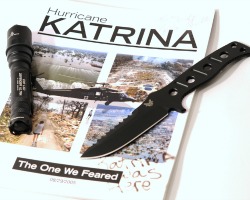
The base rifle I chose was a Franklin Armory M4 SBR-L. Why? because from the moment I held it, I knew it was the gun for me. The balance was impeccable, the billet receiver was a sensuous beauty, and the handguard was built for human hands. My hands.
I’ve never tried to hid my fondness for the Franklin AR. It’s a wonderful piece of machinery. Considering that the rifle may live for hours at a time in my tight grip, I wanted a handguard that my hands approved of and the free float is just icing on the KR cake, as is the fireproof 7075-T6 aluminum.
I also ran Katrina tests with my super-basic DPMS Panther, and my Smith & Wesson M&P15 that I tricked out as my horder rifle by loading evey cool and shiny (but still functional) accessory into it just to see how it ran. I tried to keep the DPMS as light, simple, and fluid as possible, and ran the Smith heavy and heavily accessorized knowing full well that the best and least would migrate to my Franklin.
10 Important Things for a Katrina Rifle:
Sling and Mounts
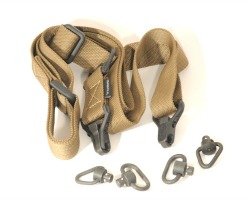
Imagine wearing the rifle on your back or across your chest for hours on end while you do other tasks and walk great distances. The rifle is slung across your shoulder while you cook, while you carry supplies, and even while you sleep. The sling must be easily adjustable and wide enough to be comfortable. The popular attachment options are clips, quick-detach, and threaded with tri-buckle. Clip connections are the most versatile and just as fast as QDs.
While dedicated QD attachment point slings are gaining popularity, they are limited by the number and location of QD ports on the rifle. But there is a solution that gives both clips and QDs equal footing and harnesses the advantages of both. QD attachment swivels with metal ovals or triangles for sling clips are strong and flexible solutions. I can also attach shoulder pads to the sling including very nice ones procured from high-end computer bags. Recommendation: Magpul MS3 with GG&G triangular QD rings.
Adjustable Stock
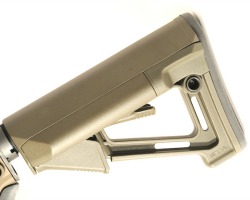
I’ll admit, the telescoping buttstocks are cool. But the practical benefits are great as well. Although long distance shooters turn up their collective noses at easily adjustable stocks because they are less stable than a fixed stock affecting accuracy at the human/gun interface, that is not of concern with a Katrina Rifle. instead, the rifle must be able to fit a variety of shooter sizes, as well as make itself as small as possible on demand.
Of the popular adjustable buttstocks, Magpul rises to the top of the heap in my opinion. The next question was which one. I narrowed it to four options in ascending order from simplest to a heavier feature filled; named the MOE, the CTR, the STR, and the ACS.
Having run each and every one through some basic paces, I decided on the second from the top, namely the Magpul STR. The STR has more cheek weld than the CTR yet retains the locking or restriction (R) feature. The STR has less storage than the ACS, but a large chunk of empty real estate in the middle like the CTR is something I like. It makes an excellent grab point and useful hole for non-standard operations. The amount of storage in the ACS was an interesting problem to consider.
On the surface, it would seem that more closet space in the stock is better, but what would go in there? A basic parts kit? Batteries? Cleaning supplies? Extra firing pins? More ammo? A compass? Knife? Fire starter? There is no end to all the survival goodies that could go in there. But a quick reality check shows that the Katrina Rifle is not the place to store supplies.
There are much better storage options. And while a tiny issue, about half an inch to be exact, the ACS is slightly longer than the STR. For the pistol grip, I kept the Ergo grip with battery compartment that was OEM on the Franklin. I like the Ergo over the Magpul, of which I have two for comparison. The Ergo is a wonderful grip and one worthy of consideration. But it certainly won’t make or break the build. Recommendation: Magpul STR Buttstock
Ambidextrous Charging Handle
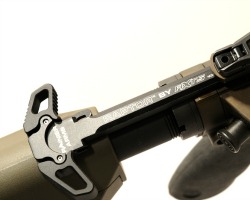
The traditional charging handle has worked for many decades so why change it? Especially with a quality ambidextrous replacement costs from $60 to $90. But something to consider is that there are three main points of operational activity on the rifle; the magazine, the charging handle, and the trigger. And the other two will be addressed in a moment. The ambidextrous charging handle does exactly what the OEM charging handle does except from either side, and either side means either hand, either palm, either hip, or either edge of any hard object.
Cycling the bolt and to move a round into battery and to clear jams are the charging handle’s main functions. Although not as sexy and conspicuous as many other AR parts, the humble charging handle can make or break the rifle. But here’s one more thing to consider: first, if you are running scope, you might need the extra lateral reach of a wider handle. And second, non-standard surfaces can be used to charge your AR in emergencies so you might want a non-standard charging handle design that considers the necessary strength and girth to handle such abuse.
The Raptor is more than just an additional paddle on the right. The Raptor was designed from the ground up for superior strength, intense durability, and record-breaking pivot point pin size. If there is a failure, it will be downstream from the Raptor charging handle. Recommendation: Rainier Arms Raptor Charging Handle
Drop-in Trigger
After market triggers are a costly upgrade. There’s no doubt about it. So why spend the money on one for a KR? Two reasons: pull weight and durability. On the pull weight side, I wanted something much lower than the off-the-shelf pull. Something in the 3-4 pound range. Some might think this a little light, but considering anyone from child to grandma must be able to pull the trigger without pulling the sight off the target, that pull weight seemed about right without going so low as to have the rifle fire the moment a finger touched the trigger.
Related: DIY AR-15 Trigger Job
Remember, this is a Katrina Rifle so I am less concerned that the rifle will go off too quickly than not at all, or at least not where it should be pointed. Durability is arguable here since the original equipment manufacturer (OEM) triggers have proven themselves strong. But that’s when things are running well. Since the trigger is a rather fragile component of the rifle, as well as one that has been known to go out of tune just when its time to solo. A few engineering upgrades in the trigger department are welcome here as well as some extra plates of steel or aluminum enclosing the trigger mechanism.
Both Timney and CMC make great drop-in triggers in the weight range I am looking for. Timney makes 3 and 4-pound drop-ins that have a majority of their intestines surrounded by aluminum. And CMC makes a 3.5 pound pull drop-in beast almost completely enclosed in steel. Both attach to the lower with more security than traditional pins offer. The Timney retails for about $25 more than the CMC, and both are available online and in stores. On a side note, it seems that some of the enclosed drop in triggers might be infringing on each other’s patents given that some product lines appear then disappear. Recommendation: CMC 3.5 lb. Drop-in Flat Trigger
Electronic Optic
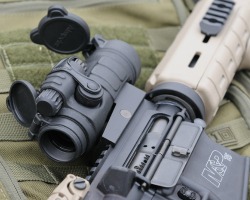
An electronic optic is always a debatable add-on. The minimalist crowd will sing the song of simplicity while the tactical troop will want every battery powered advantage. On my Katrina Rifle, I chose to mount an Aimpoint between my hard sights. The justifications are three-fold because there are undeniable advantages of a red dot over iron sights in many situations, and “Katrina” is one of those situations.
- Target acquisition is much faster with a red dot especially in dark or obscure conditions. With both eyes open, the red dot floats in the air like a video game sight. Situational awareness increases dramatically over irons especially when eye relief can vary from an inch to a foot.
- Less skill is needed to aim a red dot compared to lining up a front sight post on a target all through the center of a tiny hole inches from your eyeball. Imagine handing “Katrina” to a friend or family member who has little or no experience with the rifle.
- Red dots are so much easier to use than iron sights when injured, shooting from an awkward position, or when also struggling eye issues like smoke, dust, punches or lost glasses. EOTech makes great sights, but for this build, battery life trumps about everything.
So why not Trijicon? One simple and controversial reason: radioactivity. This is my gun and my decision. I choose not to wear an optic that emits beta particles, especially when it may reside in the same spot against my spine hour after hour, day after day, and potentially week after week. I’ve read all the technical literature on the tritium gas tubes within the Trijicon and will agree that under normal use, the amount of radioactivity from the optic is a wash in the big picture. But there are always exceptions to “normal use” and I believe that my Katrina Rifle is one of those exceptions. My call. Your mileage may vary. Recommendation: Aimpoint Comp or the new T2 Micro
Back Up Iron Sights
The need for BUIS or Back Up Iron Sights had been done to death, but in this case there are two considerations, neither of which is the decision to include them. That was obvious. The first was material. While not running a piston gun, the issue of melting is of concern. What if the front end of the ended up exposed to tremendous heat or fire. Of course the if the gun went into a furnace the rest of the Magpul polymer would fail, but ladies and gentlemen, we’ve got bigger problems if the rifle falls out of the frying pan and into the fire. Recommendation: Magpul MBUS Pro
Weapons Light
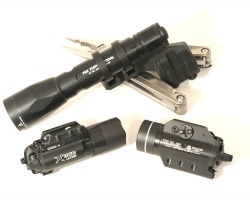
Half the day is night, and most building interiors are dependent on artificial light. When Katrina hits the fan, the rifle must operate 24/7, not just when the lighting is good. The desired qualities of the weapon’s light include:
- immensely durable and watertight body
- a blindingly bright beam pushing out at least 500 lumens
- a simple I/O interface with pulse control and no strobe
- a switch that can be operated with an object or edge as well as a finger or thumb
- a small form factor that preserves the clean lines of the handguard
- easily mounts and detaches on a Picatinny rail with one hand and without tools so it can double-duty as a flashlight
- eats lithium 123 batteries for their long shelf life, long run time, and wide operational temperature range.
I explored a 1,000 lumen flashlight installed in a Picatinny rail mount as well as a light/laser combo, and a svelte bright flashlight held in hand. In the end, I decided on a simple, powerful, and small Surefire light. The reasons include 500 lumens, a mounting system that with one hand can be quickly attached and detached from the rail, and a reputation for intense durability.
I’m sorry if I offend anyone, but if this is my last weapons light, I am choosing the best. And yes, I know there is a similar Surefire with laser, but I used to own one, and as much as I might be considered a Surefire fanboy, I was not excited with the x400 Ultra. It’s a great light, but the operational interface was not as friendly as I had hoped. But I will say that using the Streamlight TLR2-Green laser is a pleasant experience. Frankly, I am not totally sure skipping the laser is the best choice. Besides the durability issues, and the reduced battery life, the laser is larger and has two switches instead of one.
Maybe if there is a heads-up to the Katrina event, I might switch to a laser. Either way, I prefer the under-barrel mount rather than a side or top-barrel mount. The shadow is on upper side and is of little consequence when outdoors. Further, or perhaps more importantly, any reflective light spill of the barrel is on the underside so no bright spots will interfere with targeting or eye night vision. Recommendation: Surefire x300 Ultra
Stealthy Case
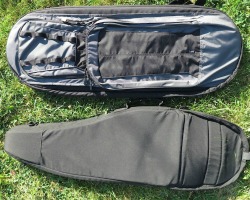
Now these last three considerations are not accessories on the Katrina Rifle, but rather for supporting the Katrina Rifle. I am done attaching things to the gun, so now I will consider the shelter, health, and feeding of the rifle. Let’s start with shelter.
Hurricane Katrina was not a surprise. The mistakes causing the WROL were 100% human initiated with everything from city planning, to emergency response, to good old human nature mixing into a perfect storm of Charlie Foxtrot.
Regardless of any updated laws or attitudes, a visible rifle will change the strategy of any observer regardless of what side of the law their body will fall on when things get wet. Casing your weapon will hide or at least confuse its shape, and some of the better stealth cases add just a couple seconds to gun deployment.
Literally, just 2.2 seconds according the Renegade Ridge when describing their Liberator Discrete AR-15 case. There are many discrete case options, with some that look more like something else that others. Popular mimicry includes tennis racquet cases, violin and guitar cases, and non-descript ovaloids that look like unknown something else. I like the 5.11 Tactical COVRT, but if price is no object, then the Renegade Ridge really rocks the boat. The RR is designed for deployment as much as discreteness, and the build quality is off the charts. Recommendation: Renegade Ridge Liberator Discrete AR-15 Case
A Parts Kit
The health of your gun is a debatable topic. If your survival scenario includes a short but intense duration like Katrina proper, then cleaning and maintenance is not at the top of your list. But if running your gun over an extended period is a concern, then having a few extra important pieces might be helpful.
Now this might sound like a contradiction since bolt action rifles have performed flawlessly for a century with no more than a light cleaning. Why would a last-ditch rifle be one that needed spare tires in the trunk? Very good question, and one I still ask myself. But the simple answer is that when using a semi-auto action, the number of moving parts increases and the chance of failure increases proportionately.
Sorry about that, but it’s reality. The path of least resistance is a commercially available parts kit like the Rock River Arms, or CMG, but with Katrina knocking, it’s just the facts maam. Just the facts. The probability of failure with the amount of ammo I plan on carrying is pretty much zero. What’s going to go wrong with a few hundred rounds downrange? Sure, Murphy is alive and well, but that is really scraping the bottom of the worry bucket. Recommendation: Rock River Arms
Ammo Solutions
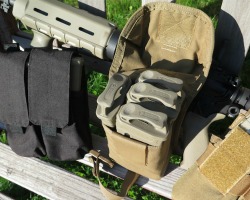
Feeding. What good is a rifle without ammo? So let’s consider some Katrina options. First, there is the 30 round mag that lives in the basement of the rifle. Think about it. Thirty shots is a seriously high number if you are really the good guy with a gun. But of course nothing goes according to plan. Especially Katrina events. So my KR is backed up with four more 30 round mags for a total of 150 bangs. Plenty of ammo on the run. That averages to five shots a day for a month. Still a lot.
The solution is a quality dual-mag pouch. Plain and simple. The pouch can be belt-worn, carried in a pack, or affixed to the rifle sling. I can wedge four 30-round Magpul PMags with Magpul Ranger Plates into a Spec-Ops four mag pouch. It’s a tight fit, but that’s just added security, right? I have other mag-holding options, but if I gotta grab just one, the Spec-Ops is it.
On a side note, I alleviate my fear of magazine spring compression-memory by loading my 30 rounders with only 20 rounds. If darkness appears on the horizon, I will pack in the remaining 10 rounds compressing the spring to its maximum. Unlike many unprepared folks, I prefer to be perpetually two thirds-ready with my Katrina Rifle magazines.
Go? No Go?
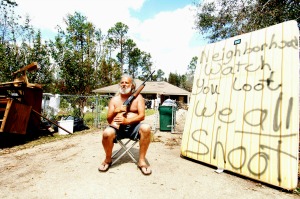
Given the amount of time I spend considering what I should have, I discovered several things I don’t need nor want for this very specific rifle. Here is the list of things I tried to implement, but gave up on or felt they weren’t the cost in weight or side effects. I consider the five things to avoid.
- The Vertical Grip
I run a VG on my Smith, but that’s all. I noticed that the number of advantages of the VG is smaller than the number of problems it creates. if shooting from hip or blasting back and forth without prejudice, then a VC is helpful. But for a full range of shooting positions and a minimum of weight, then the vertical grip can find a home somewhere else.
- A Single Point Only Sling
If a paid operator or soldier of fortune is running security for some African warlord, then the single point is ‘da bomb. But carrying a Katrina Rifle 24/7 needs a traditional sling first, and one that can go all single-point only if needed.
- A Sharp Pointed Flash Hider or Muzzle Brake
I’ll admit that there is something cool about a scalloped circle of pointed turrets on the business end of a rifle barrel, but in my non-scientific tests, I found that not only was the so-called .223 muzzle brake excessively loud, but that the sharpness did not add any more fear to the bad guy over the hellish black emptiness of 16 inches of 5.56mm diameter hole in chrome-lined steel. Making matters worse, the sharp pointed muzzle break I used snagged and caught on almost every surface the rifle slid on nose first. And trying to slide it into a soft case was at times an exercise in futility.
- The Bipod
I’ve never used a bipod that was both lightweight and stable. It’s always one or the other. Adding to that the limited number of times when you really need a bipod, my Katrina does not need this piece of jewelry to feel good about herself.
- A Scope
There is absolutely no doubt that the use of a multiplying optic increases long range accuracy. But it is also true that the nature of a Katrina Rifle does not lean more towards the long range shots. While sometimes necessary, the multi-hundred yard shots are not the priority. A scope adds weight. It limits short range target acquisition. Unless battery operated, the scope is just as susceptible to darkness as human eyes. And what’s the advantage in that. Now if things go all good on us, then I’ll be the first to scope up my AR and go hunting, but until then its Aimpoint or iron.
Class is Over
As this apocalyptic exercise comes to a close, I’m satisfied with my creation. It is certainly not the only route to a Katrina Rifle, but anyone anywhere willing to plan at this level might need a little encouragement since and camaraderie. So share your Katrina Guns in the comments below. Got solutions or disagreements? Share those as well.
Photos by: John Ferguson, Smiteme, and Doc Montana

46 comments
ok first great article. second. you said o-300. does that mean an urban rifle or are you talking more about all arounder? i’m curious because you named it a Katrina rifle and that was mostly (at least in LA) an urban affair. additionally could you talk (probably gonna have to be a future post) what you consider a SHTF combat loadout. me and others have talked about this in detail and some gravitate toward a full combat load while others think a light ammo load and mobility will be more important (think just enough to break contact—my argument is that they might not agree with your plans).
but again. great article.
The 0-300 yards is a realistic working range (about two or three city blocks) when in or near urban areas. The “Katrina” aspect is more the potential target than the specific situation. Katrina is a metaphor for an event where SHTF turns to WROL.
The variety of uses for the Katrina Rifle are many, but one possible target in particular must remain at the forefront of every decision: man. A well-thought out Katrina Rifle becomes a 24/7 extension of your person. If it’s uncomfortable to carry, too heavy, or overly complicated, then it might become more of a liability or distraction. As an exercise, wear a slinged rifle for five or more hours while you go about other chores or activities. The rifle should melt into your body and disappear from your conciseness until needed. Like a handgun in a holster or a knife in a sheath, the KR needs to blend seamlessly into your routine.
A loadout article is a good topic. The difference between my suggested ammo count a full combat load will not affect mobility speed much if at all on the surface, but it will require a second or larger container. And any more than four loaded 30rnd mags in one place becomes a logistics issue. If headed in to battle, then load up on bullets, but a Katrina Event has many more moving parts of which the rifle is just one.
Good point about the ammo choice. When things go south, buying ammo is likely not an option anymore so what you have is what you got.
However, and I do like my howevers, battlefield pickups and sharing ammo only works when the numbers are the same. If there were a dozen different fuesl for cars, wouldn’t it make the most sense to bugout in a vehicle that uses a fuel that is statistically more common than the others? Running a truck on propane, butane, methane, hydrogen, or acetylene all but ensures that one tank is all you’ll get. So tricking out a Katrina Rifle in a less popular caliber might turn it into a boat anchor sooner than its trendy friends.
(It must be intensely how to build a survival rifle reliable, of common caliber.)
Something I never worried about was common caliber ammo. I bought firearms in calibers I wanted and or wanted to do a given job. I then buy enough ammo to operate said firearm.
Common caliber firearms for those that don’t buy enough ammo up front should be given some deep thought as the last several years common calibers of ammo has been in short (to none) supply in every store in the country. But at the same time 41 Mag, 32 Mag, 7MM Mauser, 35 Rem, and lots of other non common caliber ammo has been there on the shelves.
I have lots of 32 Mag ammo as I have 4 guns that shoot it and back in the 1980″s I bought a lot of ammo. But only a year ago when there was no 9 mm, 40 cal or 45 auto there was several boxes of Federal 32 Mag on the shelf at Gander Mountain.
The prepper idea that common caliber is the only way to buy a firearm should be cross examined carefully before you buy a gun and expect to always be able to run to the store to buy ammo.
The real answer is to buy all the ammo ahead of time to allow yourself enough ammo for your guns.
And if you do stock up ahead of time it doesn’t make a difference if it’s common caliber or not as you have your own personal supply independent of supply chain shortages.
For almost all the guns I own, I had hundreds of rounds stocked up before I got the gun. And thousands of rounds after i got the gun. And lots of reloading components.
And before someone says the word “Barter” I will not be bartering any ammo or guns as they then could be used against me. You should give bartering ammo the same scrutiny before you conciser doing it.
Ask yourself “How well has common caliber ammo worked for you the last few years when you went to buy some?” And then ask if you think it will happen again.
Chuck Findlay
Ask yourself “How well has common caliber ammo worked for you the last few years when you went to buy some?” And then ask if you think it will happen again.
I still fell good with my common caliber choice. People who preach uncommon calibers during times of shortage forget one important logistical factor. While there might be a few boxes of 41 Mag, 32 Mag, 7MM Mauser, and 35 Rem on the shelf that usually is all they have. If you bought all four boxes of 41mag you would have 200 rounds and then that supply would be dry. While 22lr has been in short supply it is still the most produced round in the U.S. accounting for over 2 billion of the 9 to 10 billion rounds produced each year. The rounds people buy most are what gets produced in large quantities. Your argument is flawed. I am pretty certain just my supply of 8500 rounds of 22lr probable exceeds your total supply of on hand uncommon calibers. That is not even counting other common calibers I have on hand in large quantities. Because of my foresight I have not had to purchase one round of 22lr since Sandy Hook. My stock was closer to 10000 back than.
Bottom line is do not wait for a crisis to buy what you need or the only choice you will have is that limited amount of uncommon calibers. Most places have stacks upon stacks of 5.56 on hand, because the market is currently flooded. You will never be able to make that same statement about an uncommon caliber.
3rdMan said (While there might be a few boxes of 41 Mag, 32 Mag, 7MM Mauser, and 35 Rem on the shelf that usually is all they have. If you bought all four boxes of 41mag you would have 200 rounds and then that supply would be dry.) How dry would your supply be if you were out of ammo and went to the same store to buy 9 MM?
(People who preach uncommon calibers during times of shortage forget one important logistical factor. While there might be a few boxes of 41 Mag, 32 Mag, 7MM Mauser, and 35 Rem on the shelf that usually is all they have. If you bought all four boxes of 41mag you would have 200 rounds and then that supply would be dry. )
I could ask you the same question, What if your supply of ammo was not available to you as a flood, your house burned down or whatever and your stock was gone? And you went to the local gun store or Wally-World to buy more ammo. For the last several years 9MM, 40, 45 auto .223 were simply not in stock at all, even if you offered to pay $500.00 for a box of 50 you would not get any ammo because they DID NOT HAVE ANY. But I could throw a $20.00 bill on the counter and walk out with a box of 32 Mag ammo. I like many here stock up on ammo so it’s not a problem to me personally to see shortages. And while I may only have been able to buy 200 rounds, you would not have been able to buy any as they had none.
We all can speculate as to what may happen, But I live in a place called Realville , and in Realville history of the last several years has proven 9-MM, .223, 308 and a lot of other ammo not available to shooters who wanted to buy it. You can say all you want that they don’t make a lot of 32 Mag, but the fact that it has been on the shelf to buy for the last several years to buy when a heck of a lot of other ammo was not tells me that Your argument is flawed, not my argument.
(I am pretty certain just my supply of 8500 rounds of 22lr probable exceeds your total supply of on hand uncommon calibers.)
Don’t put any money on that bet! I have worked on and off at a friends gun shop since the late 1980’s, so your cretin guess as to my supply of ammo is a bit off. Just 7-TCU alone I have well over 2,000 rounds loaded up. (for a caliber I only shoot 500 times a year) and while I have not counted the 32 Mag ammo I would make a safe guess at close to 4,000 of that. I also have thousands and thousands of bullets, primers over 120 pounds of powder to keep reloading for years.
(Because of my foresight I have not had to purchase one round of 22lr since Sandy Hook.) I haven’t bought 22 long-rifle since it was $12.00 a brick of 500, just a guess, but that was in the early 1990’s. You are not the only one that has foresight and money to buy ammo. I would guess I have 40,000 22 long rifle rounds. I live a few miles from Camp Perry (where the National Matches are held) and I use to buy target ammo there in 5,000 round cases.
The real answer is to buy enough ammo for the guns we own, and I have done this for 35+ years.
I have a lot of firearms in common and uncommon calibers so don’t think I only buy odd caliber firearms. But I did notice the last several years that If I wanted ammo I could go to Gander Mountain and buy 32 Mag ammo and then look to the right of those boxes where the 9 MM was supposed to be and see empty shelves.
You’re simply an idiot.
Saying stupid stuff over and over again doesn’t prove a point, it merely makes plain the poverty of your thinking.
Consider not conciser doing it. Stupid auto correct…
Battlefield pickups will just as likely involve firearms along with ammo so I don’t know if that holds much water. But really I plan on avoiding any battlefield as much as I can…
Not that common calibers are good or bad. From my viewpoint it’s best to have your ammo supply sorted out ahead out time regardless of caliber..
I’m not picking on the .223 round, I have a bolt action rifle and handgun in that caliber. And .223 brass has a double use to me as I use it to reload .223 rounds and turn it into 7 MM TCU rounds. Not that I need more of either, but I still take whatever friends give me.
I hear you about avoiding the battlefield. My point about battlefield pickups was to keep my gun running, not theirs. I’d hate to trade my Katrina Rifle for someone else’s surplus .303 British. Sure, the Brit is better than nothing, but I would hope that the time, money, training I poured into Katrina’s and my relationship to last longer than a dozen dozen shots.
Keep in mind that the real Katrina was an escape, not a true TEOTWAWKI. The rest of the world was still out their just beyond reach. I have confidence that my Katrina Rifle would serve its full term in office, but if we’re talking a global grid down, I reserve the right to change my mind about some aspects of the rifle and my plan. The Katrina Rifle as described in the article is more a GOOD Rifle.
Great read – need to start my Katrina Rifle today. I am thinking M1A for my platform because I am old school.
You know Doc we are talking about battlefields within the USA, just think how bad it would really have to be for this to happen. I hope we never find out.
we’re in a “cold” civil war now already, Chuck.
it’s fortunate that the shooting hasn’t started in earnest, yet.
I know I’m not ready for it…
Nice rifle, but of prefer a handgun. I’ve seen national guard patrolling post hurricanes. Pretty sure a rifle on your back is going to be buying you some problems. Quality item of your preferred caliber and the ability to conceal. Keeping a low profile is the most important step.
I agree a handgun is probably a top choice for many preppers as its easier to keep hidden. But a rifle gives you power that few handguns can match.
My preferred rifle / handgun combo is a lever action Marlin 357 Mag and a S&W 357 Mag revolver. I have lots of handguns and rifles (30+ years of a disease called gun-nut) but the 357 Mag combo seems the best to me for a few reasons. A lever action rifle looks less threatening then a black rifle, it’s less likely to get banned as soon as an AR, it gives the 357 Mag round a 600 feet per second boost in speed over a handgun, it’s nice to have your rifle and handgun share the same round. And I can’t see the case for making it self defense if you shoot someone much over 50 yards. And the 357 Mag in a rifle or handgun is a good man stopper out past 100 yards.
I use to shoot 2 liter pop bottles full of colored water with my 6-inch 356 Mag at 200 yards and it would blow the bottle apart easily. Yea it took 4 or 5 shots to hit it at that range with the open sites, but when it did hit it sprayed water 20 feet in every direction. It really looks impressive when there is snow on the ground and you see how far the colored water fly’s from a hit. And the misses were only a few inches off, with a 1/2 size man size target it’s easy to keep almost all hits in the center body mass of the target. No a 357 Mag handgun is not a long range round, but I would not want to be hit by one at that range. or any survival situation I can think of a 357 Mag gun combo is going to do well.
For really long range shots (hunting) I would use my 22-250, but like I said, long range shooting of people is going to be murder and you are not going to be able to talk authorities into not thinking it is not murder.
And the prepper idea that government is going to suddenly disappear is a myth. The government over the years has spent billions of dollars in preserving it’s power base and it is not going away.
Sorry guys, no Mad Max world is going to happen.
For what a lot of people pay for one AR-15, I have purchased a 12 gauge pump, a Chinese model 53, and Hi-Point 40 cal carbine and a pistol (in the same caliber and using the same magazines).
I have purchased 40 cal ammo for $189 per 1000, 7.62x54r for $90 for 440. 12 ga 00 buck for $100 for 250.
Versatility is a virtue. So is frugality.
Wow, that’s something else. Good for you!
I have (thankfully) zero hurricane experience. In my past career in southern California, I had a “bit” of experience during the 1992 Rodney King Festival. I find that for my experience, the bulk of all experience in any urban or major suburban setting, an AR-15 or similar calibered rifle, either semi or bolt action, will be more than adequate for defending hearth and home. Since Katrina occurred, there has been excellent weapons designs brought to the market that give just about anyone who desires to, a workable realistic defensive capability. During the Riots, there were a very few, and I mean very few less than 10, documented incidents where folks from the riot interior areas, left in car loads to pillage other areas. They were all met with substantial force and slimed back to where they came from or were taken into custody. While local thugs took advantage of the Riots, to try and foment pillage and destruction in their local areas and a few, (very few) were somewhat successful on a very small scale, in doing that. I can see no real reason to concern ourselves with longer ranges in any urban setting, because we should be, getting OUT of the kill zones and danger zones, more than engaging targets. For more rural areas, keeping threats at longer distance would seem to be a capital idea, although I remain unconvinced for now. I would prefer looking like I/we have nothing worth approaching us, and certainly nothing worth dying for. While that may seem far too simplistic for many people, to date, being as invisible as I can be, has worked rather well so far. I always keep our family on the fringes of any “crowd” and try to get out and away from the crowd as soon as is practicable. We try to not get caught up in heavy traffic volume, especially in any urban areas and carefully plan our trips to avoid the local traffic as much as possible. Is that work? Sure is, but it keeps us far less frustrated and safe. Can I always take an AR with us when we are on road trips? Nope, but I can take an alternative that meets the idiotic requirements for various Communist locales, but they are still effective for defense out to 300 meters, which is a very long way off in urban environments. I don’t foresee us, having urban combat like in Iraq, I do see happening, what we saw in a very small way during Katrina or the riots. So, planning for a max distance of 300 meters is, an excellent compromise. great article, well written, and intelligent.
Outstandingly said, and wise.
I’m glad you noticed the posturing, TPS. The sillouette of the AR15 speaks volumes and will, in my mind, make the difference in some cases.
I’ve got a two or three US state buffer around me in all but one direction, where I can carry anything I want across any borders. However, as you noted, I am actually more concerned with what will come my way from the larger population zones when the city folk bugout. And I know they are planning to. At least a large enough percentage thanks to the advertising of the Great American Redoubt by you know who.
As Chuck pointed out, things will likely not go so far south as to be unrecoverable, but they might hit the fan for a few days or weeks. At that point when cops are only minutes, or hours away, I will need to dial in a ballistic parameter that protects me and my family. I’m sorry if others suffer the downstream effects of my actions, but I will not be the be the victim. That title belongs to someone else while me and Katrina snuggle up.
Can’t stop laughing – 1992 Rodney King Festival
Was trying to be “nice”, we called it the “Rodney King Loot, Shoot & Scoot Festival”.
I read a lot of these ‘articles’, and finally, here’s one that held my attention.
Great article — thanks for posting it.
I’ve been working on my own version of a Katrina rifle (actually 3 of them) since purchasing my first AR (a Colt SP-1) three -1/2 decades ago.
That said — I have a question and a comment on your choices.
The question is — no Night Vision ?? I would suspect in a futuristic “Katrina like” scenario, “owning the night” would be a major plus factor. At least it is for me — and a Gen 3+ NVIS on a weapons mount was a top priority in my purchases. Expensive — no doubt — but so is the result of not being able to see the aggressor.
The other “comment” is your choice of the Aimpoint over the EoTech.
The subsequent comments zeroed in on the opinion that most “conflicts” would likely be close in — 100 yds or less
I have one of each (the third being the Trijicon) on my 3 “Katrina” rifles, and while I understand the battery life issue — for under 100 yards issues, I find the EoTech to be the faster acquisition sight. AND it works perfectly with the NVIS device.
For 75 to say 200 yards, the Aimpoint is great (and it works with the NVIS), Close in — it isn’t as quick on target (for me).
For 100 plus yards, the magnification of the Trijicon is a help to these tired eyes.
But I do understand the concept of YMMV, so maybe that’s the answer.
These statements aren’t meant as a challenge to your choices, but if you have some added comments to offer, I’d appreciate it, because I’m always interested in learning.
Thanks again
Great questions GM, and fair ones.
On the NV front, I am more than happy to include NV in my bugout kit, but not on my rifle. Besides the weight, I anticipate that most if not all of the rare use of the Katrina Rifle will be in daylight or within the range of my Surefire.
NV chews through batteries and has an inordinate fondness for gravity. Adding a quality Gen3 NV to the Katrina Rifle would up the weight by several full mags. I would happily consider it for other scenarios, but not this one.
On a side note, keeping the hole in the barrel lined up with the bad guy requires muscle. And for those within the majority of America, maintaining a still rifle aimed accurately long enough to pull the trigger is something harder to do with each added ounce.
On the Aimpoint EOTech question, I too have both and I contrasted them in a Survivalcache.com article here:
https://survivalcache.com/survival-debate-aimpoint-vs-eotech-survival-optics-red-dot-vs-holographic/
On at least two occasions, I pulled my EOTech from the safe only to find the batteries dead. Since Katrina will live most of it’s childhood in the safe, I need it good-to-go always. Further, the EOTech shuts itself off after a day’s work. I plan on flipping the switch on the Aimpoint the moment it hits the fan. If we’re still in deep do-do after five years, I will swap out the battery with a new one from the storage compartment in the pistol grip.
No challenge taken, GM. In fact just the opposite. As a man of science, I appreciate threats to my paradigm. That is how our predictions get better.
Those who believe everything they think will be the first to fall. Adaptability is and humility are related. And, as Aristotle penned, “It is the mark of an educated mind to be able to entertain a thought without accepting it.” Or as I like to say, it is the mark of a educated prepper to be able to entertain alternate scenarios and solutions without buying them, but definitely learning from them.
Night vision is certainly something to consider. After Katrina, we didn’t have power for about six week. My otherwise friendly neighborhood got pretty spooky with zero lights and every “bump in the night” had your imagination going. I borrowed a friends Gen 1 monocular, and it worked out pretty well for me, but a head/helmet mounted model would have infinitely better.
just one point for chuck to consider…like you i stockpile adequate ammo for each gun i own, but what if i can’t get to it? flooded basement, house fire, caught away from home, chased away from home, or any number of scenarios could result in us being separated from our ammo. what then? better have a common caliber because you can’t tote 1k rounds every where you go. yes, cache is a good alternative, unless we’re pinned down in naw’lins and can’t get to it. just a point for your consideration. and to the commentor’s point about short range in the city, better look up bro. obviously he’s never been plinked at by serbian snipers, lol. need something that will at least splatter the masonry around his window perch and get him ducking. there are idiots everywhere who will shoot at folks just for fun if they think they can get away with it. admittedly that is worst case, but things look to be headed toward worst case soon.
Siberian snipers? Three words: Not My Problem.
One key ingredient to surviving is making the correct calls about what is your problem and what is not. A sniper in a window 300m or more away is not my problem once out of line-of-sight. I have no intention of confronting every challenge because there is no end to that road.
Instead, as hard as it is to do, I won’t become the local law enforcement. Just my own bodyguard. And bodyguards don’t take off running down the street after snipers. They protect Job #1 at all costs with moving to safety as the first option.
not siberian, serbian. you miss my point. in shtf events often water and other vital needs are shut off or damaged. nutjobs take advantage of the situation, both official and unofficial nutjobs. in one city there was only one broken water main still trickling out water. the trapped residents had to run the gauntlet of serb snipers that set up in overwatch of the water point. now imagine yourself there, trapped with no way to get to that life giving water. think it can’t happen here? neither did they. they were a modern society with all the same trappings of our civilization and days later they were dying trying to get across the street for water.
Serbian….Darn you autocorrect!
Your point is well taken. I guess if we’re pinned down then me and the boys are going hunting. But nut jobs are like mosquitos. Squish one and another pops up in his place. Sometimes the known is better than making a vacuum for an unknown.
Watering holes have been strategic choke points forever, so I guess it’s my fault if I’m stuck between a rock and a water main. Two key issues in Serbia include the element of ethnic cleansing and the utter lack of anywhere to escape to. Neither of which I forsee as an issue in my neck of the woods.
However the very recent rumblings under Yellowstone national park have thrown a monkey wrench into my bugout since ash distribution models suggest I move due west towards larger population centers and towards the same nuclear reactors whose fallout would be carried due east towards my current location on those same winds.
Talk about a 21st century choke point!
don’t go making suggestions like that, even as a bad joke Joe.
too many of us are nut jobs as it is. and a week before the “crisis”, national guardsmen were our neighbors, or our neighbors kids. I would prefer that we not be seen as a threat, by anybody out there that can still be reasoned with.
I enjoyed reading your article. For me though, I went a different route. I was in New Orleans for Katrina. Most of us carried a handgun and had a rifle or shotgun at home. In my small group of friends, when we refer to a “Katrina rifle” we are usually speaking about an AK. Katrina was pretty messy and dirty. While I would have no problem carrying one of my ARs, if there was a Katrina part two, and I needed a truck gun, I would grab my AK with Ultimak rail, Aimpoint optic and flashlight. I’m not going to walk around with a long gun hanging off my body and all my AKs have a folding stock so it’s easier to transport and put into action while in a vehicle. Handgun is always on my hip. Most of my time for weeks after Katrina was working on my flooded home and going back and forth to Lowes for repair items or searching for gas stations to refuel my truck and generators. So a lot of time in and around vehicles. I now have four AKs and my current “Katrina gun” is a PAP M92 with a brace, an Ultimak, an Aimpoint Micro and a light. The shorter barrel works great for vehicle use and having the “brace” makes it just as easy to use as any SBR. Just my $0.02. Thanks for getting the word out.
Like your choice of “Katrina Rifle” a great deal. Was looking for “something” that would work well in filthy environments and decided on the same set up, without the UltiMak and Aimpoint Micro. Went with stock brace, Hogue grip on the pistol and a few dozen extra NEW mags. Seems to work well, my brother got one for himself and his adult children as well. Sling setup is easy as well. And yes, they work well from a vehicle if needed….
Some of the sport ARs have scrapped the dust covet. It doesn’t take long to miss it when it gets dusty, wet, or pretty much any other weather other than a calm blue sky battlefield.
My complements to “Doc”; a good article, good upgrades to the AR w/o being at all “Mall-Ninja”
I carried the M-16 in its A1 and A2 variants for 13 years, both an enlisted infantryman then later as an officer.
Back in this era the A2 was considered big improvement.
For my personal rifle during this era, I built a CAR 15 upper with A2 sights with an A2 lower with the old school fixed stock. I’m 6′-3″ so even with body armor i dont need the collapsible and find i can shoot a tighter group at longer range with the fixed stock, but for my 5′-4 wife the adjustable stock is a must have item.
Later I owned the “Professional Ordinance Carbon 15” with the fluted stainless barrel.
Both I and my 10th Mountain Division Medic younger brother loved this gun, despite no forward assist and other shortcomings.
So please understand when I write its from the vantage of carrying an AR platform from the days when they were so unreliable the most infantry folks kept a little bottle of “break free CLP” in our helmet band to keep the bolt wet, and functional.
Jump forward 20 years, and I am aware the circa 2012 Mile Spec M-4 has undergone no less than 56 DOD engineering improvements since my M-16 A2 of 1991. the M16A2 was an improvement over the M16A1 to achieve 600 rounds between failures to function (FTF) Now the 2012 M-4 is up to 3,400 rounds between FTF, and toture testing the Colt AR-15 “5920” is reported at over 5000 rounds between FTF.
But old memories die hard.
Because of this, for my current AR, and for all folks; I strongly recommend the Sharps Relia-Bolt as the First upgrade for reliability.
https://store.srcarms.com/product-p/reliabolt.htm.
If I build another AR for ‘constant carry” I would use this bolt in “Windham Wapondry’s Carbon Fiber AR15, for the same reason we loved the old Carbon 15.
amazing lightweight.
Please note carbon fiber is much more durable than “polymer” which I am still skeptical about for an AR.
The other route i recommend to folks getting into an AR rifle is the Ruger SR556 or SR762.
This type of gas piston is highly reliable, but note the weight of the rifle goes up a little. the SR rifle also has a longer sight radius with its mid length foregrip, This is an aid to open sight accuracy.
For my clients on unlimited budgets the Christensen AR-10 is a impressive item.
I greatly favor my M1A scout but it is not a bug out, or constant carry rifle, unless I knew i heading to a battle, knew I would be moving by vehicle, or use for defending a limited area. But the M1a with 200 rounds in mags is up over 22lbs, vs. an AR with 300 rounds at little over 13 lbs.
So for constant carry or bug out, when there is so much more one has to carry, it makes a strong case for the AR-15, especially in Carbon Fiber.
but YMMV.
God Bless the Republic
I miss America.
Nice article. Makes much sense. But my idea is to use the same caliber as the military. You can always ambush the national guard for supplies if it’s worse than Katrina.
Doubt it’s the same over there but around here if things went dark, I bet the local NG boys would give me a mag or two if I asked nicely.
Good idea, but to me it sounds like a modern day Scout Rifle.
Personally I’m sticking to my FAL, a battle-proven weapon in a very common caliber, capable of 0-500 yard kills, which is as far as I can consistently shoot and hit a man-sized target! I think NV gear probably won’t come into play since you (and everyone else) has to sleep sometime, preferable at night! And a quiet (hope you don’t snore), unmoving target is very hard to find in the dark, especially if they don’t won’t to be found. Any person/groups in a bug-out location will have to assume that they being watched, maybe targeted, day and night and take the necessary steps for defense! OPSEC! One thing not mentioned about battlefield pick-ups is that even ammo of a different caliber has usable components such as powder, primer, (can they be removed unfired, undamaged?) and lead/projectile (a bullet mold could pay dividends) and of course, they may have value as trade items! If you have 40,000 rounds of .22LR ammo on hand, then thank you for helping to increase the ‘shortage’ and thus jack up the prices of this caliber. There, I wiped your spittle from my face! Not all of us are so rich! To the commenter who thinks shooting someone at long distance is murder, really, what bad Western movie did you crawl out of! If that person only has a handgun, do you have to wait for him to come within 50 feet before engaging, so it’ll be a fair fight! The only fair fight is the one you survive!!! As the Chinese general, Sun Tsu (sp) is credited with saying “the best battle is the one you don’t have to fight”. If you have an advantage in a fight, then you use it, even if that means you don’t engage in that battle at all or that you use booby-traps as a deterrent/force multiplier! Ambushes are one of the most effective battlefield tactics known to man, surprise is essential! As far as a sudden government collapse being impossible, guess again, large asteroid impact, super-volcano eruption, multiple nuclear explosions in different major cities (ever heard of suitcase nukes)(I’m surprised it hasn’t already happened), and you thought Katrina (and the farce of a government response) was bad! If your head feels good in the sand, then keep it there, (hint) makes you a easy target. As far as ambushing National Guard units, if the situation is that bad, then all bets are off, though I doubt they would be an easy/soft target! Even some LEOs may live in your neighborhood but that doesn’t necessarily mean they will have YOUR best interest in mind; they are still human (though some think they wear a S-emblem on their cape) and still have human needs and weaknesses. Good Luck!
Roger Said (If you have 40,000 rounds of .22LR ammo on hand, then thank you for helping to increase the ‘shortage’ and thus jack up the prices of this caliber. )
I did not help create any shortage of 22 ammo. I haven’t bought 22 ammo since the early 1990’s. And almost all my 22 ammo was free as I took it in trade for working at a friends gun shop on weekends and evenings. If you don’t have enough or can’t afford or find it, look in the mirror when you blame someone, not in my direction…
Yes I thought ahead in my ammo supply, but it’s not like you could not have done the same thing. In the 1980’s I figured out gun control and possible ammo shortages were coming. I stocked up to the extreme when it all was inexpensive and there was plenty of it around.
Do I smile when I look at the cabinet in the basement full of ammo? Yep, do I feel guilty for having it Nope…
As expensive as ammo is right now you should be buying it all you can. It’s not going to go down in price and only a fool would think there will never be another shortage coming.
As far as taking ammo apart and reusing the components in your reloading, yes it can be done. I’ve done it, it’s slow to do. primers are standard as are bullets. But you don’t really know what powder is in the cartridge and it could blow up a gun if you made a wrong guess. I never reuse the powder as I have a lot of it already and I know what it is and the right amount to use.
In a true SHTF situation I’m sure I could use powder by making an educated guess and starting with a reduced load and working up to a full power load while watching for pressure limits. One of the first sings of too much pressure is flat primers. You work up the load till the primers just start to flatten and then back off a bit. But it is still not a good thing to do. When the pressure is too high the primer is pushed out the back of the brass case a bit till it hits the bolt face. and as pressure builds the brass case then moves back against the bolt face. this pushes the primer back into the case. But it also flattens the edge of the primer and you can easily see this.
I see this in a few rifle cases I use and my 357 Mag when I use Winchester 296 powder when it’s loaded above 100% case capacity. Before you yell about this, 296 powder must be loaded above 90% case capacity or it will detonate (instead of burn fast) and the pressure will go way up beyond safe level. Several of the published loads for 296 are more then 100% case capacity. Why use it? Because it’s a very good magnum handgun powder and it gives good accuracy out of my contender and the S&W revolver. The lever action Marlin 357 Mag doesn’t seem to care what powder I use. But it likes hard cast bullets more then jacketed. The difference is a lot. Jacketed bullets shoot a 12.5 inch group at 100-yards, and hard cast lead bullets shoot a 4-inch group at 100-yards in the rifle. The 10-inch barrel contender handgun will hold a 1.5-inch group at 100-yards with jacketed bullets. Bullets, powder, primers and cases all can make a big difference in how a gun shoots. f you reload you can experiment and really get a gun to shoot well. With factory loads, not so much…
Just an observation from the north of the Emerald Isle. I read these blogs for guidance on ‘grid down’ preparation. I do not regard SHTF particularly likely, and there are far fewer firearms drifting about over here. That as maybe, I would make a couple of points, based on our recent (68-97) ‘Troubles’ that would, perhaps, have a bearing on Katrina type WROL.
1. Most events will be temporary (weeks or months). The Government will make all possible efforts to regain control. As observed during ‘Katrina’ the niceties will not always be observed. Assume acts of self defence will be held to account at a later stage – ‘neutralisation’ at 600m and ‘collateral damage’ by non-government actors will, most likely, be viewed extremely dimly.
2. Almost all hostile encounters will be short range, probably in restricted circumstances such as within a building or from within a car.
3. They will be short.
4. It is likely encounters will take place in poor light or at night, and, assuming this is some sort of ‘grid down’, without street lights or ambient artificial lights. The British Army made extensive use of night vision, even in the early days when it weighed a ton and was a bollocks to carry.
5. Most assailants will not be politically motivated fanatics, will not want to be shot, and will probably not persist if wounded, or if they face meaningful opposition.
Finally, as a side observation, offering ammunition for barter seems extraordinarily dumb, unless helping out friends or family, who you trust WITH YOUR LIFE.
I am thinking of buying a 22lr with an AR platform, due to the recent shortage of .223
ammo. Don’t know what obama will do, but expect the worst. So I have been stocking
up on 22LR hollow points. Do you think the .22 will get the job done, you know, taking
out an enemy at let’s say 100 yds? Need input on the .22lr’s versatility and reliability.
Hi Roy,
Not sure where you are but around here you have to wade through aisles of .223 to get close to the overpriced 50 rnd box of .22, but that’s not here or there.
.22 can kill. No doubt about it. But the ballistics of the round limit its effectiveness. At 100 yards your velocity drops into the triple digits and your energy can dip int the double digits depending on the ammo. In other words, barely enough oomph to make it through a couple layers of denim.
A.22 is certainly better than nothing, but on the low end of better.
You really need to retract this statement. It invalidates any useful information you have given and makes you look ignorant. A 22 can still kill…penetrate a 3/4 plywood (military standard) at over 300 yards (see Iraqveteren8888 video). A 22 has the same ballistics (meaning trajectory) as a handgun caliber….very hard to hit due to the drop due to gravity and low speed at over 150 yards but still very lethal. Can definitely penetrate more than a few layers of denim…what an ignorant statement. It will penetrate enough at 200+ yards to do the job the problem is estimating the drop correctly at an unknown EXACT range.
Great article, and you make some compelling points. One thing you may want to consider is a FAB Defense GL MAG butt stock- it’s an awesome piece of kit, and has a magazine well which stores (in my case, a full 10-round magazine).
For my “Katrina” rifle, I chose the Sig-Sauer M400 carbine. It has been absolutely 100% reliable, very accurate, and I like the solid front ladder sight- sturdy that can really take the hits without being destroyed. Not so much, for a folding front sight. I did add an adjustable gas tube to tone down the gas going to the bolt carrier (ALL ARs are overgassed), which reduces the amount of crud that enters the receiver. Plus, I run a Surefire 5.56 Mini suppressor, which does add a certain amount of backpressure. And the Eotech HHS II with the flip-over magnifier scope cowitnesses with the iron sights. Just some thoughts…..
Found your suggestions excellent as I have these items on my Ruger AR 556. I am still searching for a light I like and some spare parts kits, considering another whol3 rifle as most parts are interchangeable. Guns are cheaper than uppers or lowers bought separately. I love the red dot and my iron sights can sight right thru it. I tend to overcompensate with too much ammo, sue me. I agree with your ideas completely.